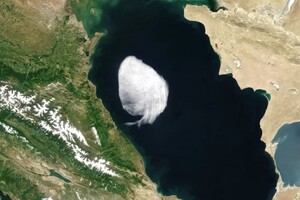Scientists are already interested in the history of its origin.

On May 28, satellites recorded an unusual cloud over the Caspian Sea , which NASA called “special”. It's an interesting example of how satellites can detect similar phenomena in Earth's atmosphere, Space.com reports.
Scientists used the Terra satellite to watch the cloud as it moved toward the ground and then dissipated. This was supposed to help them learn more about how small stratiform cumulus clouds acquire this shape.
Also read: Curiosity rover captured video of cloud movement on Mars
As a rule, cumulus clouds are formed at a low altitude above the earth's surface. This cloud was recorded at an altitude of 1500 meters. But what else made this cloud stand out from the crowd was the sharp edge that could be seen in satellite images.
“Sharp edges often form when dry, warm air coming off land collides with cooler, moist air. over the ocean, and a cloud forms at this boundary,” said Bastian van Diedenhoven, an atmospheric scientist at the Netherlands Institute for Space Research SRON.
The appearance of such a cloud in this region, and not over the ocean, is unusual. At the same time, it can be explained by the presence of the Caspian Sea – the world's largest inland body of water.
According to Didhoven, the cloud formed when warmer, drier air from the Balkans met colder, wetter air over the Caspian Sea.
The cloud began to dissipate a few hours after it was spotted by a satellite. The photo of the structure was taken late in the morning over the sea, by noon it had started moving towards the coast of Russia. The cloud completely dissipated as it began to move above the earth.
Terra is a very long-term Earth observation mission that was launched in 1999. It remains fully functional despite approaching the quarter-century mark in space.
The advantage of long-duration missions like Terra is that they allow researchers to monitor changes in Earth's environment over time. using the same sensors, which ensures consistency of measurements. Still, NASA and the National Oceanic and Atmospheric Administration (NOAA) are sending new satellites into space to collect different types of measurements — and as a backup to older missions.




